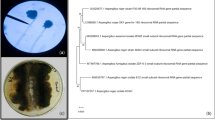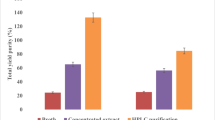Abstract
Paclitaxel is a highly toxic anticancer agent which is used in a wide range against ovarian, breast, lung, and prostate cancers. Paclitaxel is manufactured recently in the north of Iran which may lead to the introduction of the drug into the environment via pharmaceutical wastewater. To our knowledge, Paclitaxel degradation is currently performed using physicochemical methods and biological degradation of Paclitaxel has not been reported. In this study, a Paclitaxel degrading bacterium was isolated from pharmaceutical wastewater for the first time. The bacterium was identified using biochemical and molecular assays and its Paclitaxel degradation potential was evaluated using High Performance Liquid Chromatography (HPLC). In addition, kinetic and thermodynamic study of Paclitaxel degradation at different experimental conditions was performed. A Citrobacter species named as C. amalonaticus Rashtia able to degrade and utilize Paclitaxel as the sole carbon source was isolated. The isolated strain tolerated high level concentration of Paclitaxel (0.4 mg/mL) in liquid culture media and was able to degrade spillage-level concentrations of the drug (0.01–0.1 mg/mL) with 87–93 % efficacy under aerobic condition. Kinetic and thermodynamic study at different pHs (4.0, 7.0 and 10.0) and temperatures (285, 295 and 310 K) revealed that Paclitaxel degradation is a non-spontaneous process and the highest rate constant was observed in the basic condition and at the highest temperature. The ΔG values at 285, 295 and 310 K were determined 103.3, 105.9 and 109.9 kJ/mol, respectively. In addition, The ΔH and activation energy (Ea) of the process were determined +28.7 kJ/mol and +30.87 kJ/mol, respectively.
Graphical abstract











Similar content being viewed by others
References
Amann RI, Ludwig W, Schleiter KH (1995) Phylogenetic identification and in situ detection of individual microbial cells without cultivation. Microbiol Rev 59:143–169
Besse JP, Latour JF, Garric J (2012) Anticancer drugs in surface waters: what can we say about the occurrence and environmental significance of cytotoxic, cytostatic and endocrine therapy drugs? Environ Int 39(1):73–86
Biellmann JF, Branlant G, Gero-Robert M, Poiret M (1973) Dégradation bactérienne de ľacide déhydroabiétique par un Flavobacterium resinovorum. Tetrahedron 29:1227–1236
Carlier MF, Pantaloni D (1983) Taxol effect on tubulin polymerization and associated guanosine 5′-triphosphate hydrolysis. Biochem 22(20):4814–4822
Chen H (2006) Recent advances in azo dye degrading enzyme research. Curr Protein Pept Sci 7:101–111
Forgacs E, Cserhati T, Oros G (2004) Removal of synthetic dyes from wastewaters: a review. Environ Int 30:953–971
Ganesh R, Boardman GD, Michelsen D (1994) Fate of azo dyes in sludges. Water Res 28(6):1367–1376
Georg GI, Boge TC, Cheruvallath ZS, Clowers JS, Harriman GCB, Hepperle M, Park H (1995) The medicinal chemistry of taxol. Science and Applications, Taxol, pp 317–375
Hignite C, Aznaroff DL (1977) Drugs and drugs metabolites as environmental contaminants: chlorophenoxyisobutirate and salicylic acid in sewage effluent. Life Sci 20:337–341
Husain Q (2006) Potential applications of the oxidoreductive enzymes in the decolorization and detoxification of textile and other synthetic dyes from polluted water: a review. Crit Rev Biotechnol 26:201–221
Johnson AC, Jürgens MD, Williams RJ, Kümmerer K, Kortenkamp A, Sumpter JP (2008) Do cytotoxic chemotherapy drugs discharged into rivers pose a risk to the environment and human health? An overview and UK case study. J Hydrol 348(1):167–175
Kim GJ, Kim JH (2015) Enhancement of extraction efficiency of paclitaxel from biomass using ionic liquid-methanol co-solvents under acidic conditions. Process Biochem 50(6):989–996
Kim S, Seol E, Raj SM, Park S, Oh YK, Ryu DDY (2008) Various hydrogenases and formate-dependent hydrogen production in Citrobacter amalonaticus Y19. Int J Hydrogen Energy 33(5):1509–1515
Leahy JG, Colwell RR (1990) Microbial degradation of hydrocarbons in the environment. Microbiol Rev 54(3):305–315
Lessard P, Bihan LY (2003) Fixed film processes. In: Mara D, Horan NJ (eds) Handbook of water and wastewater microbiology, 1st edn. Academic press, London, pp 317–336
Martin VJ, Mohn WW (1999a) A novel aromatic-ring-hydroxylating dioxygenase from the diterpenoid-degrading bacterium Pseudomonas abietaniphila BKME-9. J Bacteriol 181(9):2675–2682
Martin VJ, Mohn WW (1999b) Recent advances in understanding resin acid biodegradation: microbial diversity and metabolism. Arch Microbiol 172(3):131–138
Montaseri H, Jamali F, Rogers JA, Micetich RG, Daneshtalab M (2004) The effect of temperature, ph, and different solubilizing agents on stability of taxol. Iran J Pharm Sci 1(1):43–51
Oh YK, Kim HJ, Park S, Kim MS, Ryu DDY (2008) Metabolic-flux analysis of hydrogen production pathway in Citrobacter amalonaticus Y19. Int J Hydrogen Energy 33(5):1471–1482
Pharmacopeia US (2001) Use caution, avoid confusion. USP Quality Review 76:1–6
Rodriguez CS (2009) Enzymatic biotransformation of synthetic dyes. Curr Drug Metab 10:1048–1054
Rowney NC, Johnson AC, Williams RJ (2009) Cytotoxic drugs in drinking water: a prediction and risk assessment exercise for the Thames catchment in the United Kingdom. Environ Toxicol Chem 28:2733–2743
Sei K, Miyagaki K, Kakinoki T, Fukugasako K, Inoue D, Ike M (2013) Isolation and characterization of bacterial strains that have high ability to degrade 1, 4-dioxane as a sole carbon and energy source. Biodegradation 24(5):665–674
Vyas DM, Kadow JF (1995) Paclitaxel: a unique tubulin interacting anticancer agent. Prog Med Chem 32:289
Wall ME, Wani MC (1995) Camptothecin and taxol: discovery to clinic—thirteenth Bruce F. Cain Memorial Award Lecture. Cancer Res 55(4):753–760
Westman EL, Canova MJ, Radhi IJ, Koteva K, Kireeva I, Waglechner N, Wright GD (2012) Bacterial inactivation of the anticancer drug doxorubicin. Chem Biol 19(10):1255–1264
Zhang J, Chang VW, Giannis A, Wang JY (2013) Removal of cytostatic drugs from aquatic environment: a review. Sci Total Environ 445:281–298
Acknowledgments
The authors would like to thank Sobhan Oncology pharmaceutical company for providing the facilities to carry out this work.
Author information
Authors and Affiliations
Corresponding author
Rights and permissions
About this article
Cite this article
Zamani, H., Grakoee, S.R. & Rakhshaee, R. Microbial degradation of Paclitaxel using Citrobacter amalonaticus Rashtia isolated from pharmaceutical wastewater: kinetic and thermodynamic study. World J Microbiol Biotechnol 32, 129 (2016). https://doi.org/10.1007/s11274-016-2087-3
Received:
Accepted:
Published:
DOI: https://doi.org/10.1007/s11274-016-2087-3




